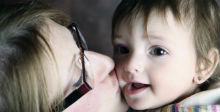Internal mini form
Contact Us Today
When a child is born with Cerebral Palsy, his or her neurological condition is affected by a brain injury or malformation. Although the brain injury will not progress, the impairment caused by the injury requires management and neurological functioning will be monitored.
Generally, a child’s diagnosis is made by a neurologist who will then become an integral part of a child’s medical team. He or she will be able to determine what medications and treatments are required to maintain neurological health. The child will be evaluated for seizures, intellectual impairment, learning disabilities, and hearing or vision loss.
What is neurologic health?
Cerebral Palsy is caused by brain injury or brain malformation that occurs while the brain is still developing — during the fetal stage, at birth, or after birth — in areas of the brain that affect motor control. The damage does not progress, which differentiates Cerebral Palsy from similar conditions. However, accompanying health conditions, such as epilepsy, intellectual impairment, hearing and visual impairment or loss, and learning disabilities, can change over time.
The brain damage that causes Cerebral Palsy is a result of either:
- Prenatal disturbance of brain cell migration – Genetic and environmental factors disturb brain cell migration as cells move to their appropriate location during brain development.
- Prenatal poor myelination (insulation) of developing nerve cell fibers – Brain function is impeded when poor myelin provides an inadequate protective covering over nerve cells that aid in transmission.
- Perinatal brain cell death – Events in the birthing process that rupture blood vessels or starve oxygen to the brain.
- Postnatal non-functional or inappropriate connections (synapses) between brain cells – Trauma, infections, and asphyxia that damage connections developed in the brain.
The brain injury or brain malformation in Cerebral Palsy is the result of one of four types of brain damage that cause motor impairment. The four types are:
- Cerebral Dysgenesis – brain malformation or abnormal brain development
- Hypoxic-Ischemic Encephalopath, (HIE) or Intrapartum Asphyxia – lack of oxygen to the brain, also known as asphyxia
- Intracranial Hemorrhage, or IVH – brain hemorrhage
- Periventricular Leukomalacia, or PVL – damage to the white matter tissue in the brain
Neurologists and neuroradiologists are essential in diagnosing the brain injury or brain abnormality that caused Cerebral Palsy. They also attempt to discern the cause of the brain damage, but cause may not be determined in all cases. Neurologists specialize in diagnosing and treating disorders of the central nervous system, such as brain, muscles, and nerves, while neuroradiologists specialize in clinical imaging, therapy, and the science of the central and peripheral nervous system.
These medical specialists prefer to perform MRIs or CT scans to aid in diagnosis. In severe cases, cranial ultrasounds may be ordered at specific times after birth. No definitive test can predict or determine Cerebral Palsy. In most cases, it is not formally diagnosed until the brain is more fully developed and the child’s growth and development can be observed over time.
Seizures, autism, apraxia, and intellectual impairment are some of the most common neurological conditions that may also accompany Cerebral Palsy.
Seizures are commonly associated with Cerebral Palsy
It is estimated that as many as half of those with Cerebral Palsy are also affected by seizures. Several types of seizures exist:
- Focal seizures – In focal (partial) seizures, activity registers in a portion of the brain and can be called “simple” when not impacting awareness or memory; or, “complex” when momentarily affecting awareness or memory. Focal seizures generally do not cause loss of consciousness.
- Petit mal seizures – In petit mal seizures, a short-term loss of consciousness occurs, but lasts only a few seconds with rapid recovery. During this time, the person’s speech or activity may momentarily stop.
- Tonic-clonic seizures – A tonic-clonic, formerly known as grand mal, seizure is the most common type of seizure for those with Cerebral Palsy. In a tonic-clonic state, the person may cry out, stiffen, fall to the ground, shake or jerk, and bite the tongue. The electrical activity is registered as full-brain.
Intellectual impairment is found in a majority of Cerebral Palsy cases
It is estimated that two-thirds of Cerebral Palsy cases will also be diagnosed with an intellectual impairment. This is more common in cases of spastic quadriplegia than other forms of Cerebral Palsy. Intellectual impairment affects a person’s ability to communicate, care for self, and socialize. A person with intellectual impairment may have trouble learning, thinking, solving problems, and reasoning.
Neurological damage can impair a person’s speech capabilities. With Cerebral Palsy, the brain damage results in a muscular control condition. It does not result in an intellectual impairment, although both conditions can co-exist.
Other Neurologic Conditions May Co-Exist with Cerebral Palsy
A child’s perception is sometimes affected. Partial or total hearing and/or vision loss is also common. In most cases, the brain damage that caused Cerebral Palsy differs from the brain damage that leads to other neurologic conditions. When this happens, they are referred to as co-mitigating factors, meaning they are separate conditions both requiring treatment.
Neurologic conditions which may be associated or co-existing with Cerebral Palsy include:
- Apraxia
- Autism
- Cognitive impairment
- Communication difficulties
- Epilepsy
- Intellectual impairment
- Learning disabilities
- Mental health
- Neurological impairment
- Pervasive developmental disorder
- Progressive development disease
- Psychological disorder
- Psychosocial problems
- Seizure disorder

Associative conditions
Cerebral Palsy affects muscle tone, gross and fine motor functions, balance, coordination, and posture. These conditions are mainly orthopedic in nature and are considered primary conditions of Cerebral Palsy. There are associative conditions, like seizures and intellectual impairment that are common in individuals with Cerebral Palsy. And, there are co-mitigating factors that co-exist with Cerebral Palsy, but are unrelated to it. Understanding conditions commonly associated with Cerebral Palsy will enhance your ability to manage your child’s unique health concerns.
Associative Conditions
Common associative conditions
Click on a condition listed below to learn more.








